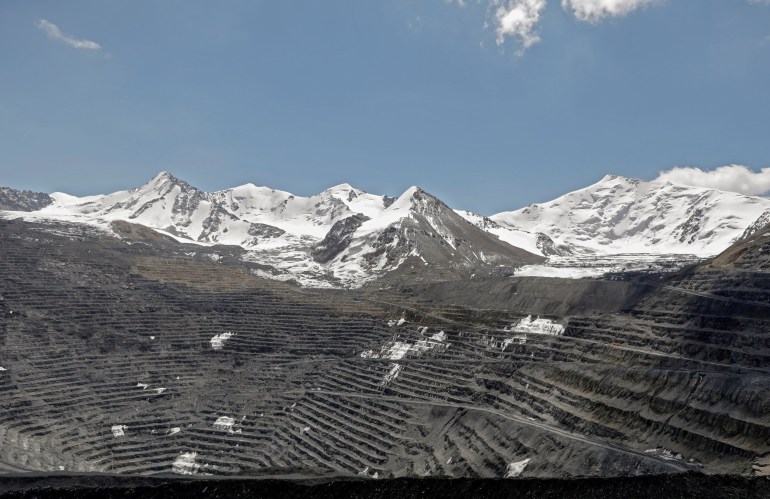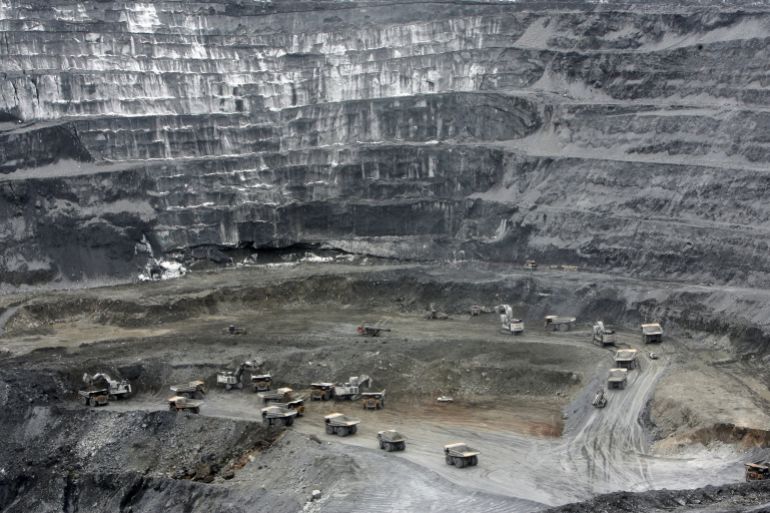Kyrgyzstan moves to nationalise gold mine run by Canadian company
Tensions between Kyrgyzstan and Canada’s Centerra Gold simmer as the president, a longtime critic of foreign ownership, effectively brings the Kumtor mine back into state’s hands.

A worker holds a polished gold alloy bar in a workshop at Kumtor gold mine extraction factory in the Tien Shan mountains, some 350km (218 miles) southeast of the capital Bishkek near the Chinese border March 14 [File: Shamil Zhumatov/Reuters]
Bishkek and Issyk-Kul Region, Kyrgyzstan – In the early 1990s, it was hoped that a large gold mine in eastern Kyrgyzstan, near the Chinese border, would lift the newly independent country’s economy out of the shatters of Soviet central planning.
But 30 years into its operation, Kumtor has for many come to symbolise some of the developing world’s greatest ills: corruption, environmental degradation and neocolonial greed.
In May, it became clear that dark clouds had gathered over Centerra Gold Inc, a Canadian-registered company operating the high-altitude mine, 26 percent of which belongs to the Kyrgyz state.
First, a court ruled that the mine had committed environmental violations by dumping
mining waste on glaciers, a move that caused their gradual erosion and cost the state $3bn.
Soon after, the parliament backed a proposal of the special commission on Kumtor to introduce state management at the mine for three months.
 Most Kumtor workers come from the Issyk-Kul region, a picturesque lake area, where the mine is based [Agnieszka Pikulicka-Wilczewska/Al Jazeera]
Most Kumtor workers come from the Issyk-Kul region, a picturesque lake area, where the mine is based [Agnieszka Pikulicka-Wilczewska/Al Jazeera]Later, a number of high-profile politicians accused of financial crimes related to Kumtor were arrested.
In response, Centerra Gold initiated binding arbitration proceedings against the government for what they viewed as a violation of mutual agreements.
Its Kyrgyz units – Kumtor Gold Co and Kumtor Operating Co – applied for bankruptcy in a US court and the company says it will seek compensation from the government.
“In 1994, after the Kyrgyz people gained independence and with your help, we began building the Kumtor Gold Mine with an initial life of 18 years. To this day, what we created together is something special that engineers from all over the world come to study,” Scott Perry, Centerra’s president and CEO, wrote in a statement.
“The seizure of the mine is based on false information and groundless allegations that undermine everything we have built together. We fear that the government’s unjustified action will put thousands of well-paying jobs and the businesses of hundreds of Kyrgyz suppliers at risk.”
Perceived as ‘source of elite enrichment’
Pressure grew on Centerra after January’s presidential elections, which saw Japarov sweep to victory after a campaign promising national revival.
He had been designated to rule the country as interim president and prime minister following an uprising last October against political corruption and a disputed parliamentary election, the third upheaval since the country’s independence.
And it was gold that brought him to power.
Months before winning a landslide, he was freed from prison where he was serving an 11-and-a-half-year sentence for kidnapping a local official during one of his protests against Kumtor.
Since 2013, he has been the main figure in the movement against foreign corporations he accuses of exploiting Kyrgyzstan’s scarce resources.
 A general view shows the Kumtor open pit gold mine at an altitude of about 4,000 metres (13,123 feet) above sea level in the Tien Shan mountains, Kyrgyzstan [File: Vladimir Pirogov/Reuters]
A general view shows the Kumtor open pit gold mine at an altitude of about 4,000 metres (13,123 feet) above sea level in the Tien Shan mountains, Kyrgyzstan [File: Vladimir Pirogov/Reuters]Many locals shared his view.
“Over 30 years of mining based economic model, the extraction of natural resources became perceived by the populations as another source of elite enrichment,” Asel Doolotkeldieva, a researcher in the Kyrgyz capital Bishkek focused on the politics of resource extraction, told Al Jazeera.
“They believe that investors, together with the elite, seek to enrich themselves, plunge the resources and go away as soon as the resources are emptied.
“The extractive industry provides only 3 percent of jobs nationwide. The mines are being exploited, the resources are being emptied, the government is getting richer but local communities, despite some development and charity projects, do not see a direct impact on their lives.”
 The Issyk-Kul region hosts Kumtor, one of the highest gold mines in the world, and is also the birthplace of President Sadyr Japarov [Agnieszka Pikulicka-Wilczewska/Al Jazeera]
The Issyk-Kul region hosts Kumtor, one of the highest gold mines in the world, and is also the birthplace of President Sadyr Japarov [Agnieszka Pikulicka-Wilczewska/Al Jazeera]“The waste is being stored on glaciers, and according to estimates, after the exploitation of Kumtor ends, it will weigh 1.8 billion tonnes. It will remain there and influence the environment. The glaciers are one of the sources of water of the Kumtor River, which flows into Taragai River, and then to Naryn River – Syr Daria, the biggest transboundary river of Central Asia,” Kalia Moldogazieva, an expert in environmental protection, told Al Jazeera.
“We have spoken against the Kumtor project from the very beginning because it is located in the glacier zone. Glaciers melt due to global warming anyway and in Kumtor, they are additionally affected by the anthropogenic factors.”
Miner support for Japarov
In February 1995, Murat was not prepared for the job. The temperature was -45 degrees Celsius (-49 degrees Fahrenheit) when his feet first touched the mountain that was meant to be Kyrgyzstan’s pride.
The dry freezing wind at 4,000 metres (13,123 feet) above the sea level made it hard to breathe.
“I have never seen anything like that before. We felt like we were on another planet,” said Murat, 59, who worked in Kumtor for eight years. “They [company bosses] invited us for dinner in a hall that looked like a restaurant. Then they gave us canned coke. It was the first time I saw it.”
He quit in 2003, and by that time he had managed to build a house at the Issyk-Kul lake, where Japarov hails from, and supported his relatives for many years.
Work in Kumtor was hard, Murat said, but the company was a fair employer.
Overtime was paid double, safety was always a priority and he was grateful that he could work with the newest technology.
“We received medals every five years, clothes, gifts. They were good to us and at the time we
were only thinking about ourselves, our families, money. Everyone wanted to get rich.”
 Kyrgyzstan’s President Sadyr Japarov speaks after voting in the constitutional referendum in Bishkek, Kyrgyzstan, April 11, 2021 [File: Sultan Dosaliev/Kyrgyz Presidential Press Service/Handout via Reuters]
Kyrgyzstan’s President Sadyr Japarov speaks after voting in the constitutional referendum in Bishkek, Kyrgyzstan, April 11, 2021 [File: Sultan Dosaliev/Kyrgyz Presidential Press Service/Handout via Reuters]“Kyrgyzstan was not ready for that. We agreed for gold extraction a bit too early. Our technology was not good enough to operate high up in the mountains, in the cold. Now we deserve Japarov. We’re done with the lies.”
Murat shows pictures from his Kumtor years and a nostalgic mood takes him over.
Soon after, he reaches out for a small book: poems to Japarov written by his supporters when he was still in prison.
“May Sadyr be released! He will get the work done! He was punished for no reason, if someone like him comes to power, he will clean our country of dirt.”
 A general view of the Kumtor mine in Kyrgyzstan [File: Vladimir Piragov/Reuters]
A general view of the Kumtor mine in Kyrgyzstan [File: Vladimir Piragov/Reuters]
No comments:
Post a Comment